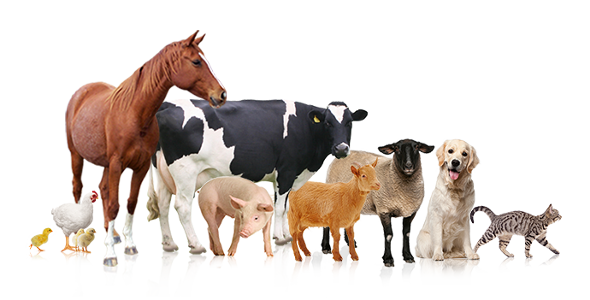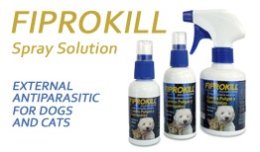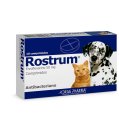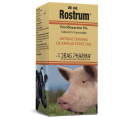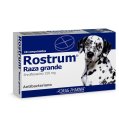ROSTRUM® 2.5% - Oral Suspension
Antibacterial
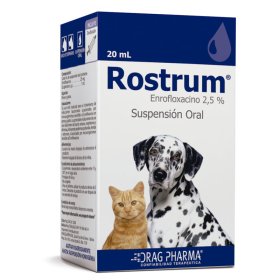
Rostrum®, is a broad spectrum antibacterial, recommended for the treatment of:
- Gastrointestinal tract infections (Escherichia coli, Salmonella spp., Proteus spp.).
- Respiratory tract infections (Pasteurella spp., Bordetella spp., Klebsiella spp.).
- Genitourinary infections such as nephritis, pyelonephritis, cystitis. (Escherichia coli, Corynebacteriumpyogenes, Staphylococcus aureus, Streptococcus spp. And Pseudomonas aeruginosa).
- Skin infections
- Infections of the external auditory canal and otitis (Escherichia coli, Staphylococcus aureus, Streptococcus spp. And Pseudomonas aeruginosa).
- Dermatitis, infected wounds (Escherichia coli, Klebsiella spp., Staphylococcus aureus, Streptococcus spp. And Pseudomonas aeruginosa).
Technical Specification
Species
Dogs and cats.
Dosage form
Oral Suspension
Therapeutic action
Antibacterial
Composition
Each mL of oral suspension contains:
Enrofloxacin ....................... 25 mg
Excipients c.s.p. .................. 1 mL
Properties
Enrofloxacin is a synthetic antimicrobial agent belonging to the Fluoroquinolone family, which are characterized by being bactericidal antibiotics that have powerful antibacterial activity against a wide variety of microorganisms, mainly against Gram negative, Gram positive, Mycoplasma and Chlamydial bacteria.
Indications
Rostrum®, is a broad spectrum antibacterial, recommended for the treatment of:
- Gastrointestinal tract infections (Escherichia coli, Salmonella spp., Proteus spp.).
- Respiratory tract infections (Pasteurella spp., Bordetella spp., Klebsiella spp.).
- Genitourinary infections such as nephritis, pyelonephritis, cystitis. (Escherichia coli, Corynebacteriumpyogenes, Staphylococcus aureus, Streptococcus spp. And Pseudomonas aeruginosa).
- Skin infections
- Infections of the external auditory canal and otitis (Escherichia coli, Staphylococcus aureus, Streptococcus spp. And Pseudomonas aeruginosa).
- Dermatitis, infected wounds (Escherichia coli, Klebsiella spp., Staphylococcus aureus, Streptococcus spp. And Pseudomonas aeruginosa).
Route od administration and dosage
Via oral administration.
Dose of the active principle:
- Dogs: 5 - 20 mg / Kg of body weight once a day for 7-10 days. The dose can be administered as a single dose or divided into two equal doses, administered every 12 hours.
- Cats: 5 mg / Kg of body weight once a day for 7-10 days. The dose can be administered as a single dose or divided into two equal doses, administered every 12 hours. In case of mycoplasma infection, the duration of treatment should be 14 to 21 days.
Product dosage:
- Dogs: 1 to 4 mL every 5 Kg of body weight every 24 hours * for 7 - 10 days.
- Cats: 1 mL every 5 Kg of body weight every 24 hours * for 7-10 days.
* The dose can be administered as a single dose or divided into two equal doses, administered every 12 hours. In case of mycoplasmosis, the duration of treatment should be 14 to 21 days.
Drug interactions
- Compounds containing di or trivalent cations such as Aluminum, Calcium, Magnesium, Iron or Zinc can decrease the absorption of Enrofloxacin. Thus, for example antacids containing cations (Mg2 +, Al3 +, Ca2 +) can bind Enrofloxacin and prevent its absorption.
- Sucralfate can inhibit the absorption of Enrofloxacin. It is recommended to separate both dosages for at least two hours.
- Enrofloxacin administered with Theophylline can increase your serum levels. In dogs, theophylline clearance was reduced by 43% when it was administered in conjunction with Enrofloxacin at a dose of 5 mg / Kg every 24 hours.
- Concomitant administration with other drugs that have hepatic metabolism may affect the pharmacokinetics of one or both drugs.
Contraindications
- Enrofloxacin is contraindicated in animals with hypersensitivity to quinolones.
- Do not administer to small to medium breed dogs under 1 year old, or to large breed dogs under 1 ½ years.
- Do not administer to cats under 8 weeks of age.
- The use of Enrofloxacin can generate the formation of crystals in urine, for which it is recommended not to administer in dehydrated animals.
- Do not administer in pregnant or lactating females.
Special precautions for use
Fluoroquinolones, such as Enrofloxacin, should not be used as the first line of treatment, unless there is no therapeutic alternative available. When used as a second treatment, it should be based on susceptibility studies.
Special precautions for the operator
Wash your hands after administering the product.
Warnings
Keep out of the reach of children.
Adverse effects
- Arthropathies have been reported in immature animals, especially dogs. The risk of arthropathy increases when the dose is increased, however it has also been reported when the recommended doses in dogs are used.
- Other adverse effects that have been reported in very rare cases (less than 1 animal in 10,000 animals, including isolated reports) include vomiting, anorexia, increased liver enzymes, ataxia, seizures, depression, lethargy and nervousness.
Observations
Special precautions for disposal of unused product or waste material:
Discard any unused product remains in its original container. Do not throw the empty container or with product remains, in rivers, lakes or streams of natural water. Dispose of this product waste carefully with household waste.
Conservation
- Store at room temperature between 15 and 30 ° C in a dry place.
- Protect yourself from light.
- Do not freeze.
- Once opened, use the product within 3 months. Discard the unused product after that period of time.
Condition of sale
Sale with retained Veterinary Medical prescription.
Presentation
20 mL bottle
Prepared by
Laboratorio Drag Pharma Chile Invetec S.A.
Records
Chile: Reg. S.A.G. N° 2038
Bolivia: Reg. SENASAG PUV-F-N° 006146/14
Costa Rica: MAG CL4-5-60-6094
Related products
You have entered drug info or veterinary products intended exclusively (s) kind (s) indicated (s).
Drag Pharma Lab is not responsible for the consequences of misuse of the products, and the use of this information without consulting a veterinarian
